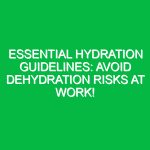“`html
Essential Human Performance Guidelines: Avoid Common Workplace Risks
Good morning team! Today, we’re diving into an incredibly important topic: Essential Human Performance Guidelines and how we can all work together to avoid common workplace risks. Understanding these guidelines is crucial not just for compliance, but for ensuring our own Safety and the safety of our coworkers. Let’s explore why this topic matters and how we can apply these concepts daily.
Understanding Essential Human Performance Guidelines
So, what exactly are Essential Human Performance Guidelines? These guidelines encompass a set of Best Practices designed to enhance human performance while reducing the likelihood of errors and accidents in the workplace. They are vital for ensuring that we perform our tasks safely and effectively.
Incorporating these guidelines into our daily operations can lead to a more productive work Environment and a significant reduction in workplace Hazards. One common misconception is that safety is solely the responsibility of management. In reality, every employee plays a crucial role in maintaining a safe workplace.
Key Hazards, Risks, and Safety Considerations
Let’s take a look at some of the specific hazards and risks associated with ignoring these essential guidelines:
- Physical Hazards: These include slips, trips, and falls, which are among the leading causes of workplace injuries.
- Equipment Misuse: Failure to follow safety protocols when operating machinery can lead to severe accidents.
- Human Error: Simple mistakes can escalate into serious incidents, especially when proper Procedures are not followed.
Ignoring safety protocols can have real-world consequences. For example, a slip and fall incident can lead to not only injuries but also lost productivity and increased insurance costs. By adhering to these human performance guidelines, we can significantly mitigate these risks.
Best Practices, Procedures, & Actionable Advice
Now, let’s discuss some Best Practices that you can implement immediately to enhance your safety at work:
- Stay Aware: Always be conscious of your surroundings. If you notice a hazard, report it immediately.
- Follow Procedures: Adhere to all safety protocols and procedures, especially when operating equipment.
- Practice Good Communication: Always communicate clearly and effectively with your coworkers, especially when working as a team.
Here’s a real-life incident that illustrates the importance of these practices: In a manufacturing plant, an employee disregarded safety protocols while operating a machine. This led to a near-miss incident that could have resulted in severe injury. Fortunately, another coworker noticed the Unsafe Behavior and intervened. This incident underscores the importance of teamwork and communication in maintaining a safe workplace.
Regulations, Standards, and Compliance
It’s essential to understand that compliance with safety Regulations is not just a legal obligation; it’s also a moral duty. Regulatory bodies such as OSHA (Occupational Safety and Health Administration) set forth guidelines that help protect employees. Here are a few key points to consider:
- Understand Your Rights: Every employee has the right to a safe workplace. Know your rights and responsibilities.
- Training and Education: Attend all safety Training sessions provided by your employer. This training is designed to keep you informed about potential hazards and Safe Practices.
- Reporting Incidents: Always report safety incidents, no matter how minor they may seem. Each report can help improve safety protocols.
Compliance is critical because it protects not only individual employees but also the organization as a whole. A culture of safety leads to fewer accidents, lower insurance costs, and improved employee morale.
Employee Engagement & Discussion
Now, let’s open the floor for discussion. I’d like you to think about the following questions:
- What safety challenges have you encountered related to human performance?
- How can we improve communication about safety in our team?
- Are there specific guidelines you feel could be better implemented in our workplace?
Your input is invaluable. Engaging in these discussions not only promotes awareness but also fosters a culture of safety within our workplace.
Conclusion & Key Takeaways
To wrap up, let’s summarize the main points we’ve discussed today:
- Understanding the Essential Human Performance Guidelines is crucial for maintaining a safe workplace.
- Identifying and addressing hazards can prevent accidents and injuries.
- Compliance with safety regulations is a shared responsibility among all employees.
By applying these practices, we can create a safer working environment for ourselves and our colleagues. Thank you all for your attention and commitment to prioritizing safety in our workplace. Remember, safety is not just a priority; it’s a way of life.
“`


